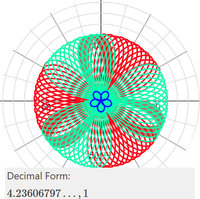First, this comment shows how badly you need to upgrade your knowledge base. Most who don't know the details would claim that [math]\zeta (-1) = \sum_{n = 1}^{\infty} n \to \infty[/math] and certainly would not be negative. But the [math]\zeta (z)[/math] only works for this summation for Re(z) > 1. To do z = -1 we need to analytically continue the [math]\zeta[/math] function to handle the negative numbers. This means that [math]\zeta (-1)[/math] is no longer defined as [math]\sum_{n = 1}^{ \infty } n[/math]. That you don't know this is telling... Like I said before you need to learn Complex Analysis. Without it your arguments are sorely lacking.
Please apply your ridicule to yourself: you clearly do not understand the implications of the "arithmetic expression".
The expression circumvents the need to involve imaginary numbers / analytic continuation whatsoever. The whole value in proving RH lies in being able to access information relating to the distribution of primes. That is why they need to confirm that the real value is always 1/2. The problem is, using the zeta function is a crude brute-force that misses the point. This is not a mathematical problem, but a number theory one. That the sum of the infinite series 1+2+3+4... equals -1/12 should immediately indicate that the real number system is a closed system, thus information relating to the primes is encoded in the original identity through which the entire imaginary number system flows: whatever co-exists with the real-number '1'.
The expression derived finds this "imaginary" value which co-exists on/as '1': Φ³.
Pi expresses itself as a/the curve(s) in relation to phi's "r", thus the two are co-creators.
The expression confirms that all "real" values are 1/2 for two reasons:
i. it derives the emergence of
i as an imaginary into the real number system at point-of-entry, thus isolates '1'
ii. it shows that all real values have analytic continuity counter-parts about the critical line according to Φ³
Therefor the problem is handled from both angles: concerning 1 and/or concerning i, and this, not even yet considering that the "arithmetic expression" contains the blueprints of all possible primes, which is the very thing the proving of the RH is after.
And it is all contained on one... if I am well informed: "arithmetic expression". Sounds elegant to me.
Mathematics and Physics are two different fields of study. Physicists use Mathematics but we tend to use a more "primitive" form of Mathematics that can often only be justified by the Mathematicians, not the other way around.
They are one and the same: you can not have any math whatsoever without the fundamental space/time aspects of motion.
That means: physics. Physics first, not math - all math must obey physics, else is not math describing the physical universe.
See
here. Specifically under the heading "Classic Definition". Again, putting the [math]\pi[/math]s into your formula [math]\dfrac{ \pi }{ \pi } \phi[/math] does not change [math]\phi[/math] into anything.
I never claimed Φ "changes" into anything: Φ is Φ. It is when π is introduced to phi that the co-operation occurs: their "relationship" generates the primes. It is like frequency: you have three terms over a fourth. You have a base note (base of the expression, circular π) and you have three which form a chord, or triangle, or any such shape one desires.
I'm not going to be as crude as JeffM but what you are talking about and how you are talking about it merely shows your ignorance in regard to how little you know about this stuff. You need to learn alot more Math in order to discuss this intelligently.
I think you might be projecting here.
Since you don't seem to understand this after several people have told you this and that you have been ignoring them means you really aren't open for discussion about what you haven't yet learned. I'm going to slightly modify JeffM's comment: Until you start to listen to people that clearly know more than you do you are little more than a troll and need to be banned.
I'm out.
-Dan

